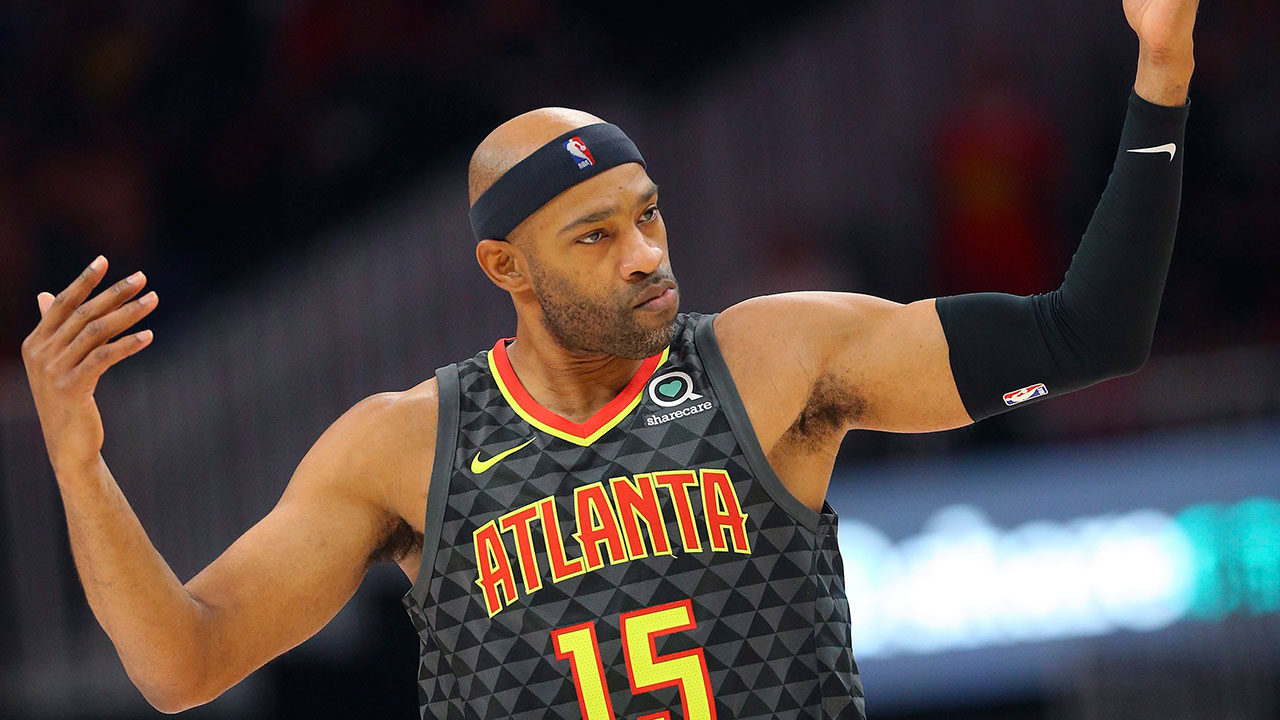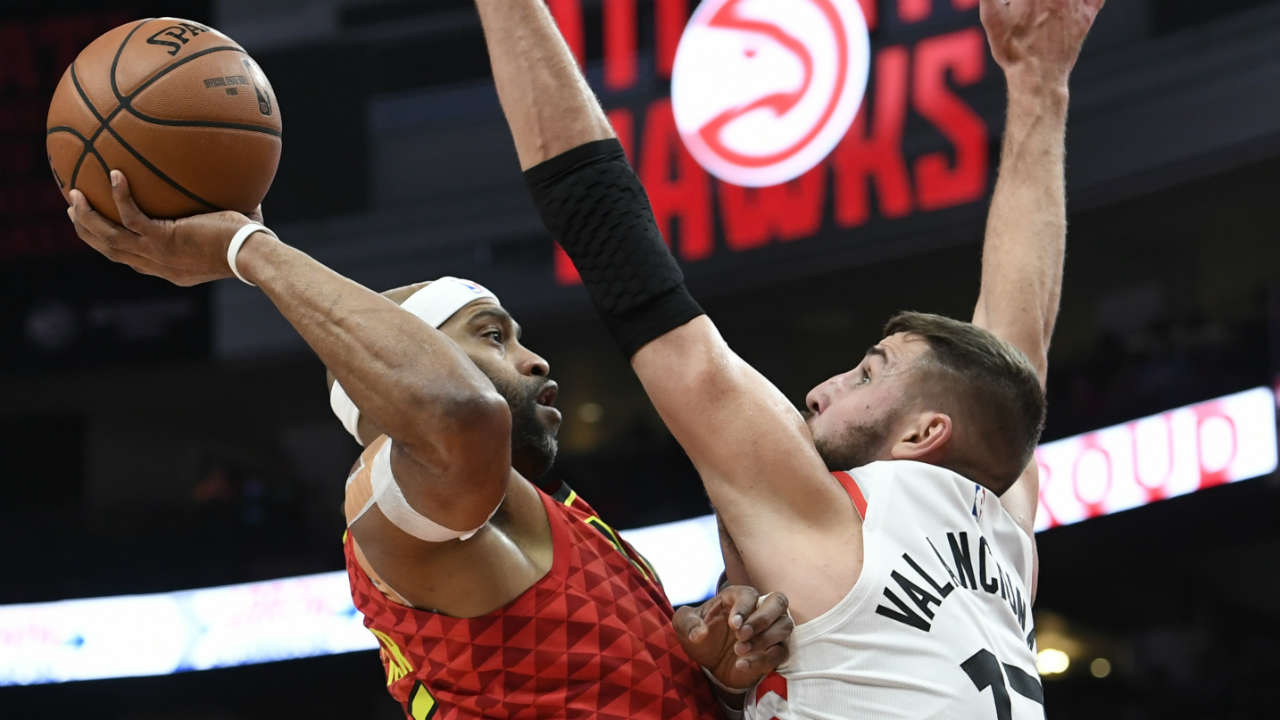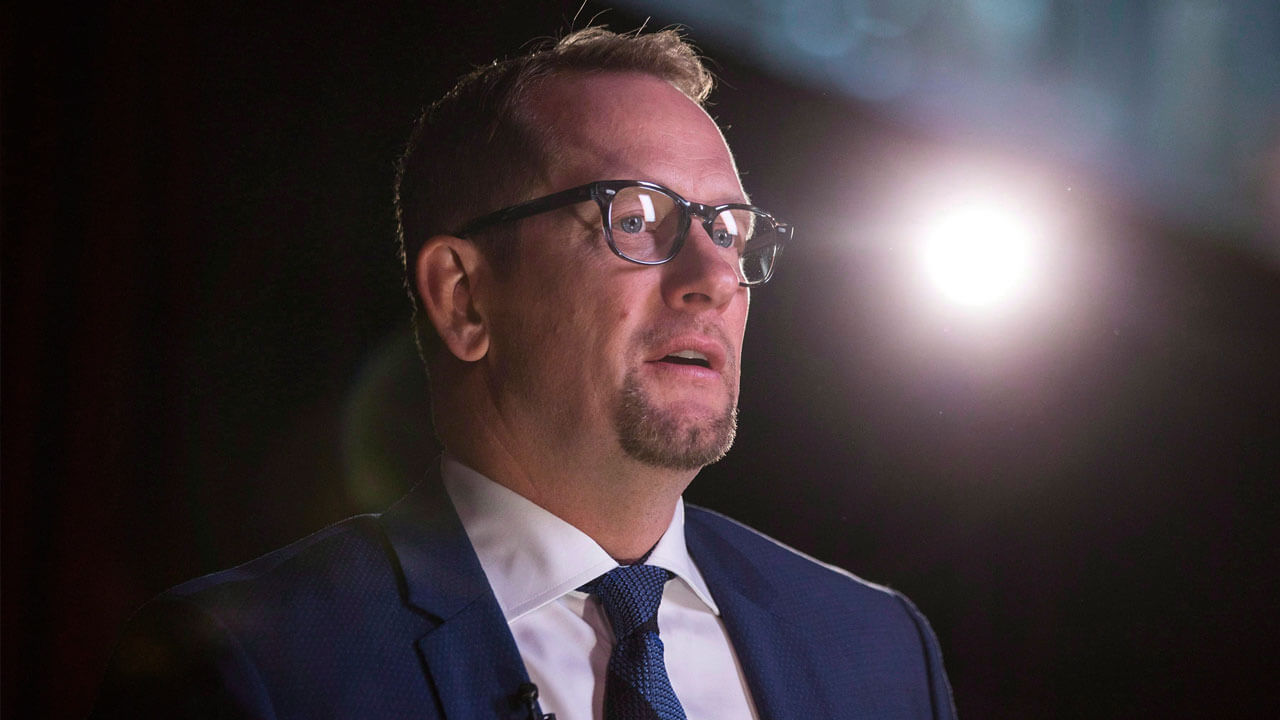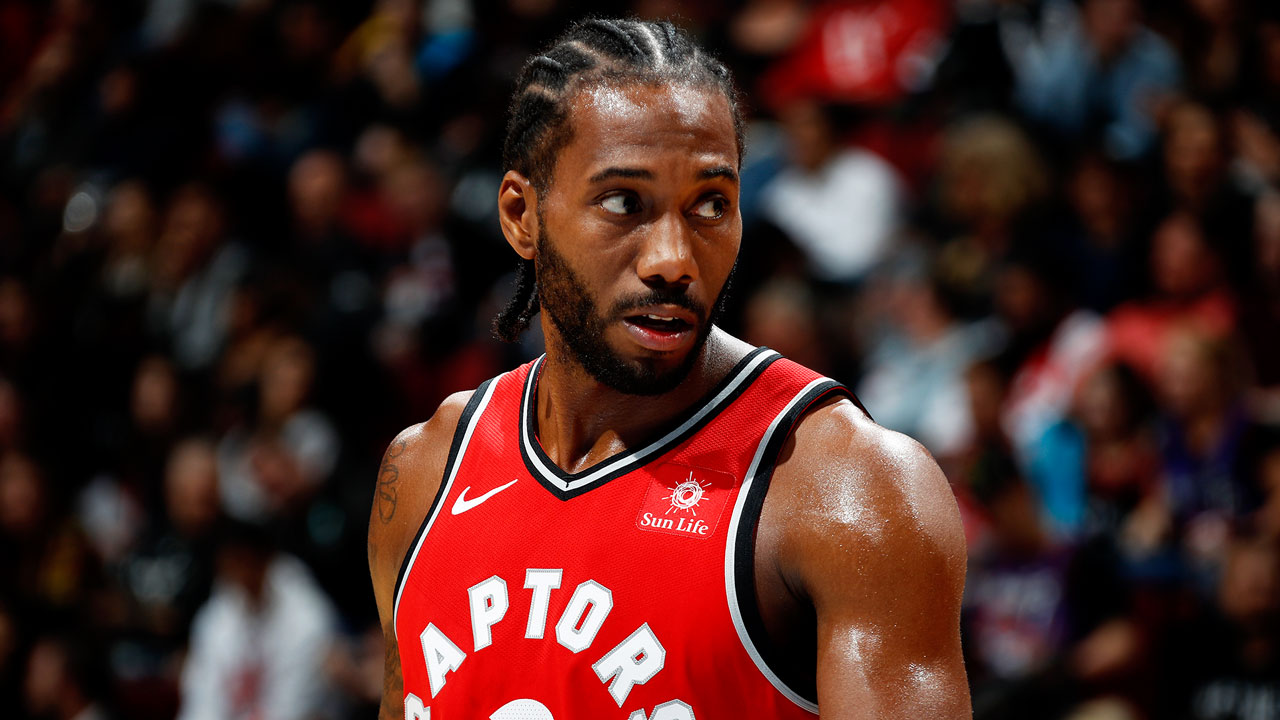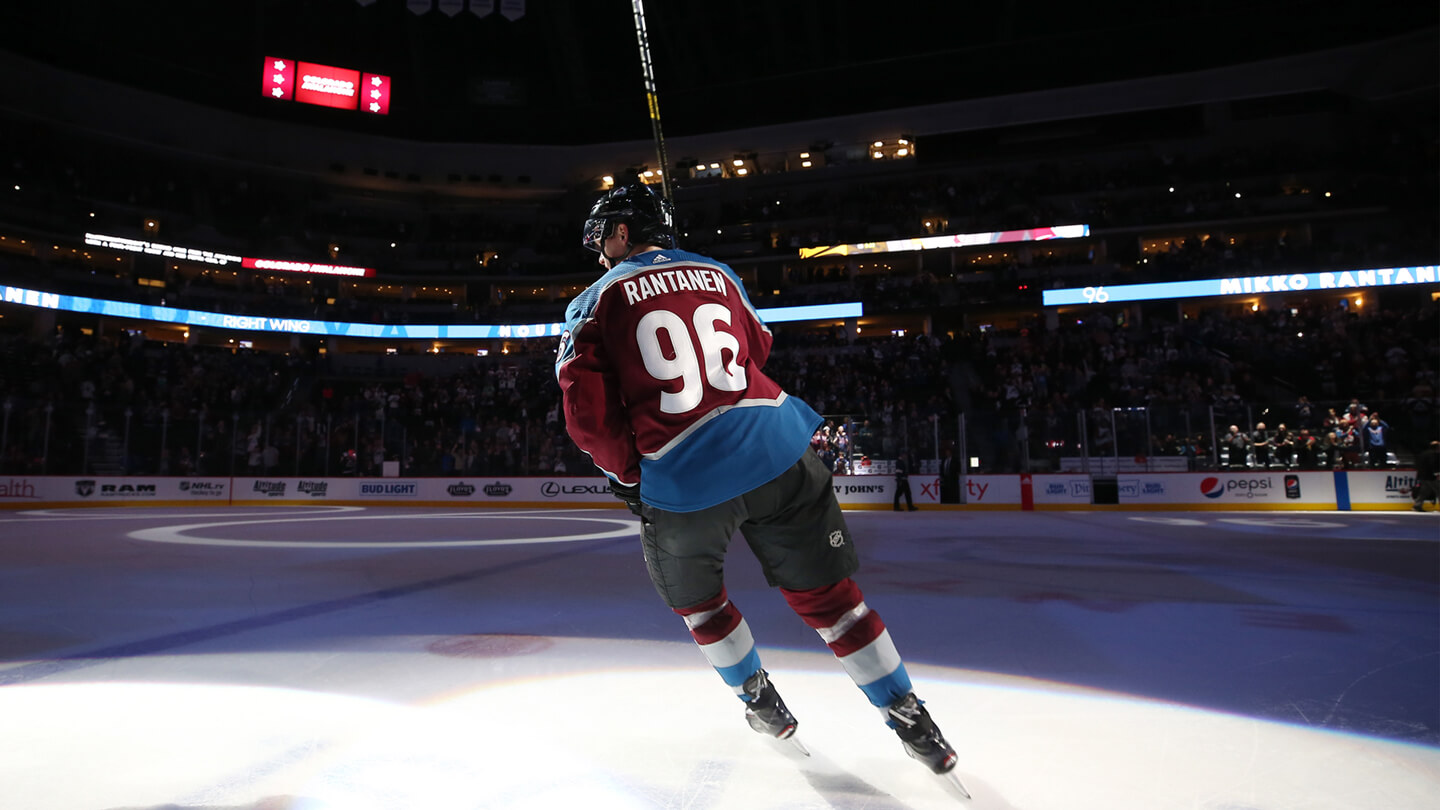As you’d expect from a story about Vince Carter, this begins with a dunk. Well, actually, a failed dunk. It’s late in the fourth quarter of a November contest between Carter’s Atlanta Hawks and the visiting Miami Heat. The home side is nursing a four-point lead when Kent Bazemore intercepts a pass, then drives up the floor. He scans for teammates and spots Carter, who’s calling for the ball behind the three-point line on the right wing. Carter catches the pass and his movements suddenly seem automatic, like breathing. Dunking is hard-wired into the circuitry for the 41-year-old at this stage of his storied NBA career.
Carter pump-fakes a three and after his man bites, he exploits the opening and follows it to the front of the net where 21-year-old, six-foot-10 centre Bam Adebayo is waiting for him. They both know what’s up. So does the home crowd, and you can imagine the anticipation: Watching Carter stunt on youth with a dunk is deeply satisfying to those old enough to remember his glory days. It’s almost like Jay-Z stepping in the booth to out-rap a generation that wasn’t even alive when his first album dropped. “That’s just in his DNA,” says Kevin Willis, Carter’s former teammate with the Toronto Raptors and a Georgia resident who frequents Hawks games. “That’s Vince.”
This time, though, the outstretched arm of a jumping Adebayo simply proves too much. Carter is forced to slightly change direction in mid-air and doesn’t quite make it to the rim. He settles for a weak push of the ball toward the net as gravity betrays him. The ball bounces off the rim and away toward the baseline.
Carter is disappointed, no doubt, but he’s also wise enough to know this foiled attempt can bear fruit: It’s a teachable moment. Seated with Bazemore in the locker room following the game, Carter breaks down the play in detail. He tells Bazemore that the opening he saw flashed him back to the moment before his vicious 2005 posterization of Alonzo Mourning, then he compares the two scenarios — what happened and what he hoped would happen — with photographic clarity. “That really shocked me because I didn’t think there was a science behind dunking on someone,” Bazemore says now. “I thought you just had to jump higher than someone. But the way he broke the play down really assured me that he was a master at playing above the rim. His train of thought: Knowing that he had to get off the ground first and was looking for Bam Adebayo to lift him up even more [to help him] finish it.”
Bazemore left State Farm Arena that night still in awe. And Carter’s lessons didn’t stop at the workplace — they continued on the team plane and then the podcast he and Bazemore co-host. The whole evening gives you a good sense of who the man once dubbed “Vinsanity” and “Air Canada” is in the final act of his career. He can still compete physically and earn minutes, but the truly immeasurable value he offers comes through his work as a sensei. Once defined almost entirely by his otherworldly athleticism, Vince Carter is now one of the NBA’s premier player-coaches.
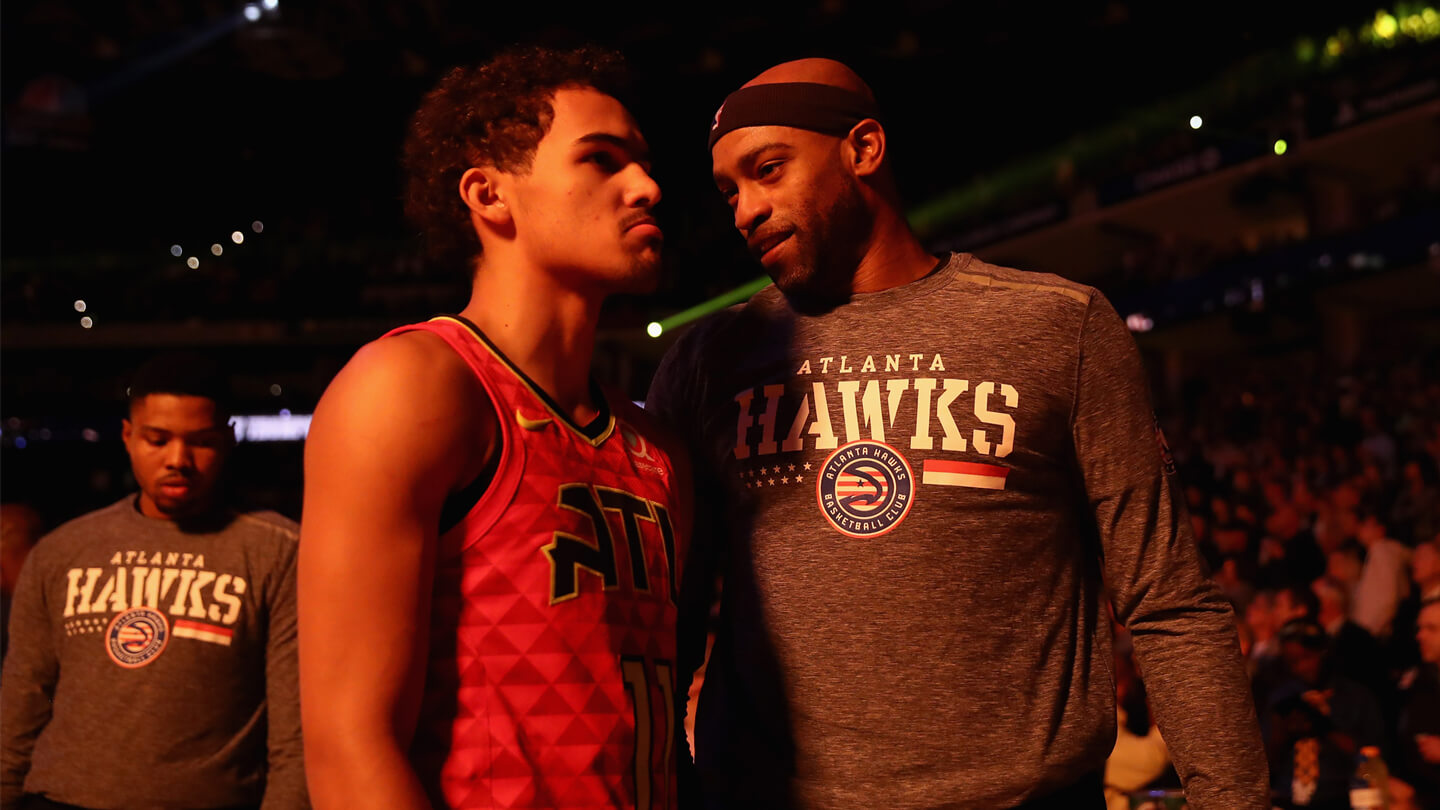
Carter’s stint with the Dallas Mavericks created the blueprint for the player he’s become today. It’s where he first transitioned to a bench role — a Texas-sized pill to swallow for someone who’d ascended to his level of stardom — and he thrived there. Carter was 35 when he arrived in Dallas in 2011, having spent the previous three seasons with three different teams (New Jersey, Orlando and Phoenix). The Mavs were fresh off an NBA title and presented Carter, who signed a three-year deal, with a chance to finally capture that elusive ring. It never came — Dallas made two playoffs with Carter, but failed to advance past the first round.
If there was any hint of the negative reputation he’d earned at the end of his time in Toronto —from the infamous decision to attend his college graduation ceremony on the day of Game 7 of the 2001 Eastern Conference semifinals among other things — still following him to The Lone Star State, it was gone by the end of his contract. Mark Cuban, the team’s owner, famously told media that he desperately wanted to get Carter a ring, adding that he’s a “warrior” and “all these things I’ve heard in the past about him being soft and not playing hard, f— that. That dude comes out to deliver every f—ing night.”
Particularly impressive to Cuban was Carter’s evolution into a full-time sixth-man during his second season with the Mavericks. With his body no longer able to handle the demands of 30-plus minutes per night, his shift to the bench was graceful, with Carter taking on more mentorship. “Vince is all about team. It was never an issue at all,” Cuban tells Sportsnet in a recent interview. “He isn’t only supportive. He has a sense of humour and a connection to players that grew up admiring [him]. Between the voice of his experience and his stories, he was great with the young guys.”
It wasn’t just the iconic, super-human dunks and 50-point nights of his youth that afforded him instant credibility at practice or in the locker room. His work ethic also demanded colossal respect. Jae Crowder was one of the young Mavs players who looked up to Carter. His 2012–13 rookie season coincided with Carter’s move to the Dallas bench, where the two had plenty of conversations. “He really took me in. He was the person I went to for guidance on and off the court,” says Crowder, now with the Utah Jazz. “He was always talking about how to prepare for games and how to be a professional and how to remain professional when things don’t go your way — because it’s not always going to go your way in the NBA. He really taught me how to take my job seriously and take the NBA as a profession.”
Crowder’s career took off a few years later, following a trade to Boston, yet he credits Carter with providing him the tools to be successful. The veteran spent hours in the film room with him, emphasizing that time as vital homework. Carter also preached the importance of building a strong relationship with Rick Carlisle, and whatever other head coaches he might end up playing under. It was important to have that open line of communication with every coach you play for, he told Crowder, advice that sounded a little funny because Carter often seemed like part of the coaching staff himself. “Vince Carter — 100 per cent a player-coach,” says Crowder.
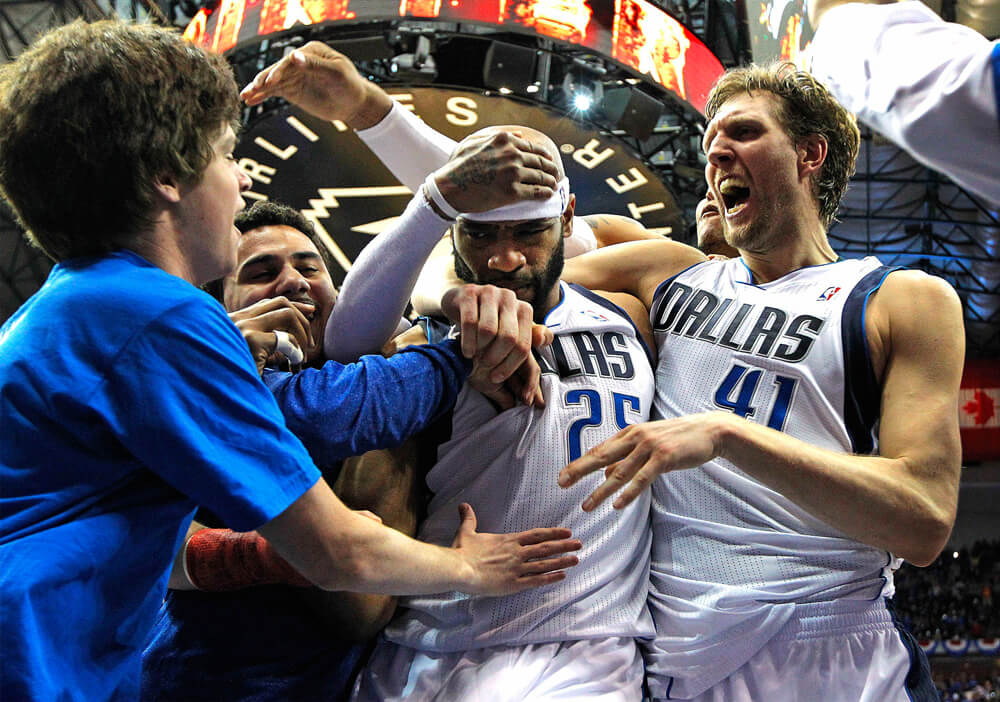
I love my Vince, man.”
The words come from the mouth of Duane Ticknor, who was an assistant coach with the Memphis Grizzlies when Carter signed there after Dallas and coached him again as part of the Sacramento Kings staff. Really, though, the phrase could’ve come from anyone speaking about late-career Carter. The Grizzlies were a contender when he joined in 2014 and featured a veteran core of Marc Gasol, Mike Conley, Zach Randolph and Tony Allen. Carter still earned his minutes, though, averaging 19.6 per game over three seasons, including 24.6 per during his final campaign in Memphis, as a 40-year-old. “That’s important,” Ticknor says. “To maintain credibility, you still have to be part of the action.”
The assistant coach joined the Kings ahead of the 2016–17 season and was reunited with Carter the next summer when he signed a one-year deal. It was a completely different dynamic than in Memphis, with a bevy of raw, young talent. Ticknor says the Kings wanted to change the culture in Sacramento, and Carter often acted as a middle man between coaches and players. When a message needed to be delivered, it was sometimes more poignant coming from Carter than Ticknor or head coach Dave Joerger. A staple of Carter’s tutelage has always been to pull players aside and offer individual instruction, so as not to embarrass them. He was rarely vocal in front of the entire group, but when the situation called for it, he operated with a deft, impactful touch.
The Kings struggled mightily despite those efforts, posting a 27-55 record that featured plenty of losing streaks. During one such stretch, Ticknor recalls the team returning to the locker room despondent after another defeat. Carter, in a tone that was more businesslike than impassioned, began to preach the importance of growth. “The wins will come in time,” he said. “As long as we keep competing hard and getting better and putting the effort in at practice and games, our time will come.” Imagine one of those speeches you see in sports films, minus the dramatic violin playing in the background. “He had everyone’s attention,” recalls Ticknor. “It wasn’t just other players. He had the whole room. He owned the room.”
Carter hadn’t forgotten what young players need to hear, that they need reassurance and guidance. When he first broke into the league in 1998, he got exactly that from Willis, who was to the Raptors what Carter is now — a battle-tested sage. Willis joined the club as a 36-year-old with a 14-year NBA résumé and quickly grew close with the rookie Carter. He describes the young athletic dynamo as a sponge for the wisdom of the locker room OGs. “He wanted to learn and absorb as much as he possibly could to make himself better,” says Willis. “The biggest thing was he was very respectful. That was great: Just having the ability to be disciplined and listen and know that whatever we were telling him, it’s only going to benefit him and let him go out there and do what he did.”
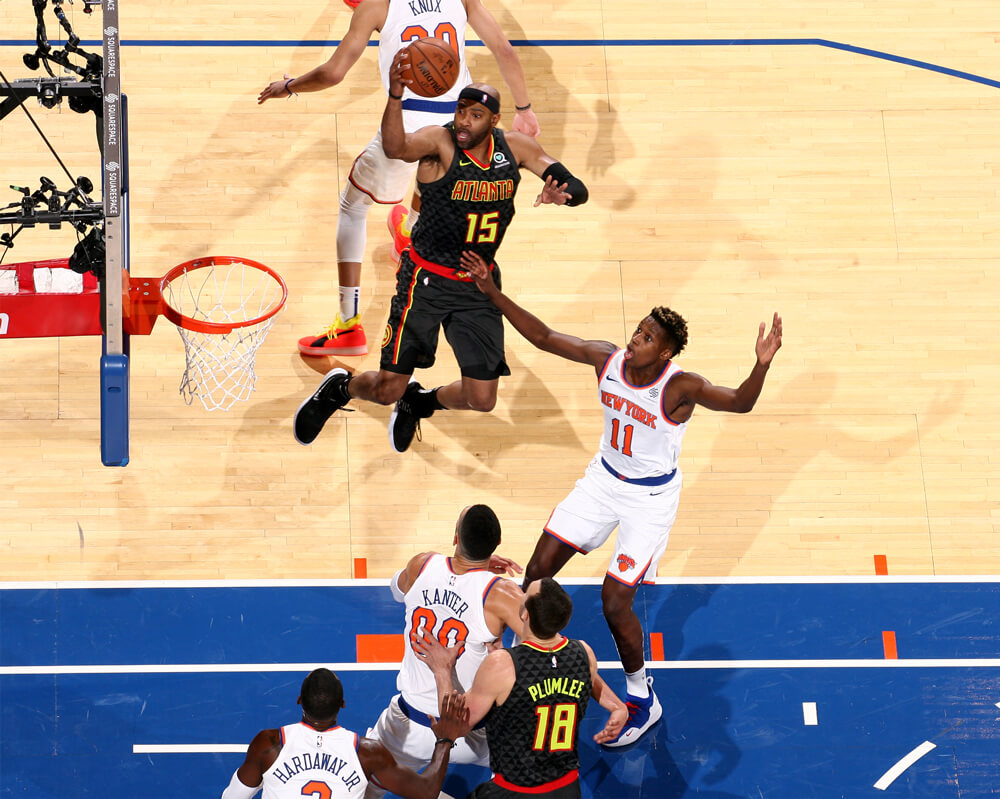
Two decades later, Carter was actively paying it forward, making himself accessible to young teammates at all times. In Philadelphia during a December 2017 road trip, he got a text at 2:40 a.m. from Willie Cauley-Stein. The centre had been lying in bed, ruminating on his goals and decided to reach out to the Kings leader for advice on how he could take his career to the next level. Carter immediately hit him back, highlighting the importance of sacrifice, and mental and physical advancement. “He just had a certain demeanour about him that made guys receptive to what he had to say,” says Garrett Temple, who was one of Carter’s veteran running mates with the Kings. Temple, now with the Grizzlies, says Carter showed him the value of having a consistent routine and also mapped out a possible path for the rest of the 32-year-old’s NBA future. “He mentioned to me that I was a guy that can easily be in the league and be 38 and go to a team that wants to bring in veteran leadership.”
It wasn’t all stoic Mr. Miyagi lessons from Carter, though. He knew how to enjoy himself. Practice was his realm, allowing for unchained creativity, like a vintage Rap City freestyle. Teammates were treated to windmill dunks and 360s, often accompanied by a sly, swagger-infused smile. “There were lightbulb moments when he would go up and dunk at practice and you’re like, ‘He’s still probably the best dunker on our team and he’s the oldest guy in the NBA,’” remembers Temple. “Wow. He’s 41. He’s not supposed to be doing that.” Mini games during practice were also opportunities for spectacle. “Especially when young guys like Buddy Hield started talking shit,” says Temple. “Vince would hit a three and talk right back to him. He’s a competitor.”
Carter’s time with the Kings lasted just the one season before he moved on to the Hawks last summer. With him and Temple both gone, the Sacramento coaching staff worried about the atmosphere that would be left in their young locker room. However, second-year players such as De’Aaron Fox and Bogdan Bogdanovic have taken steps forward on and off the court, thanks in part to Carter and Temple, says Ticknor. “I think those two guys were the building blocks and it’s carried over to this year. Even though they’re not here, their presence is still felt.
“Sometimes people look at Vince’s basketball career and it overshadows what a great human being he is,” the coach adds, unprompted. “He’s a Hall of Famer on the court, but he might be a better person off the court. He’s one of the greatest guys I’ve ever been around.”
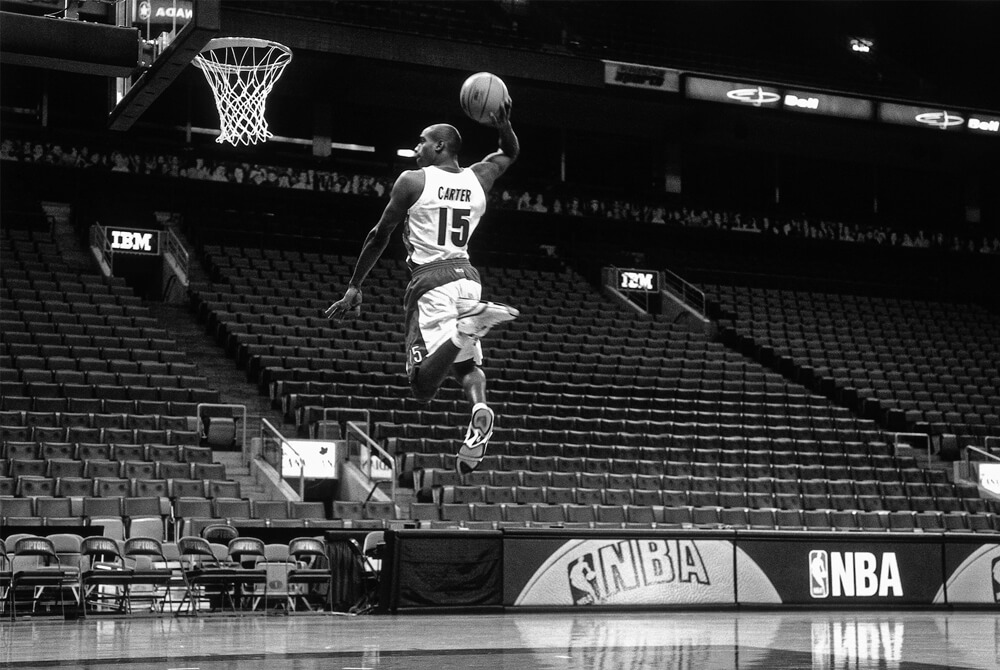
Carter met Bazemore this past summer at the Chris Tucker Foundation celebrity golf tournament in Stone Mountain, Ga. The new Hawks teammates hit it off immediately on the driving range and soon after began crafting plans for the season. Carter talked about making the game easier for the younger players, creating a comfort zone in which they could thrive. Bazemore, at 29, would play a big part in that, they figured.
As the campaign began, Carter took rookie phenom Trae Young under his wing, frequently providing the point guard with tidbits he picked up about the position from former teammate Jason Kidd. “Vince is an open book,” says Bazemore. “Very selfless guy; cares about the development of people.”
Carter’s locker is positioned next to Young’s in the Atlanta locker room, but the seat next to him on team flights is reserved for Bazemore. The pair have become golf buddies on the road and also work together on that podcast, Winging It. The show is a vessel for Carter to pour out stories about his time in the game, and also serves as a way to fine-tune his broadcast skills, an avenue he wants to pursue once his playing days are finally over.
Bazemore grew up admiring Carter and even confesses to having owned all his signature sneakers. It’s not lost on him that he’s now sharing a roster and hosting duties with his hero. A moment of crystallization occurred during the taping of a recent episode, when Warriors stars Steph Curry and Andre Iguodala dropped by Bazemore’s place in Atlanta to record, then took turns on the host’s golf simulator with Carter. “I’m like a kid in a candy store,” he says. “[During the recording] I was sitting in my gentlemen’s lounge just in awe … chatting it up with them was really like a dream come true.”
The NBA’s elder statesman doesn’t need to co-host a weekly podcast. From the outside, it would seem like he doesn’t even need to be playing. No one would begrudge Carter for hanging up the jersey right now. But, as he prepares to turn 42 later this month, Carter’s path and his résumé are both uniquely his own. Though he still doesn’t have that ring and has bounced from team to team late in his career, instead of chasing a title in his twilight, he’s opted to rove to cities like Sacramento and Atlanta, where he can earn his minutes and pass on knowledge. “He loves the game,” says Cuban. “He loves to play. I think he went to places [where] he could get on the court and lead, not just in basketball terms, but in matters of professionalism and what it takes to sustain an NBA career.”
“He made a push for [a title] when he was in his prime, and it just didn’t happen,” reflects Willis, who won a ring with San Antonio in 2003, when he was 40. “You gotta give a guy respect, because he didn’t go jump on the Warriors team or anything like that. Any team that was willing to give him an opportunity to play for them, he took it. He didn’t say, ‘Well, nah, I don’t feel like going through this rebuild stage, been-there-done-that,’ type of thing. He says, ‘Hey, this is a great opportunity, they want me to come and play in their organization.’”
Whenever Willis catches a Hawks game, he makes sure to speak with Carter, either before or after the contest. Seeing the player who he helped shepherd into the NBA makes the 56-year-old feel young again. “You look up and time just flies by,” he says. “I remember when he was a rookie … Vince would call me ‘OG.’ I was like, ‘If you’re lucky, you’re going to be in the same spot one day.’ And when I see him now, I kind of tease him and say, ‘You are where I was 20 years ago.’
“He’s the OG now.”
Designed and edited by Evan Rosser

